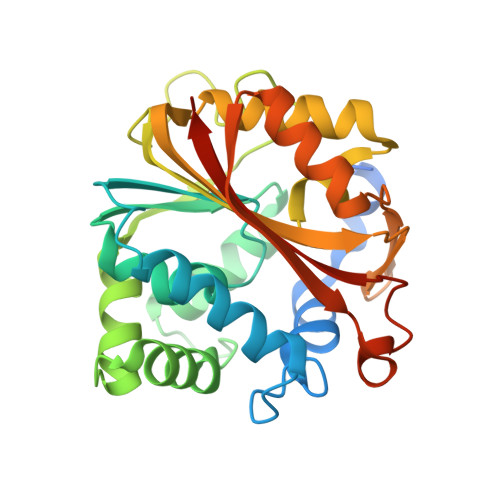Comparison of the Binding of 3-Fluoromethyl-7-sulfonyl-1,2,3,4-tetrahydroisoquinolines with Their Isosteric Sulfonamides to the Active Site of Phenylethanolamine N-Methyltransferase
Grunewald, G.L., Seim, M.R., Regier, R.C., Martin, J.L., Gee, C.L., Drinkwater, N., Criscione, K.R.(2006) J Med Chem 49: 5424-5433
- PubMed: 16942016
- DOI: https://doi.org/10.1021/jm060466d
- Primary Citation of Related Structures:
2G8N - PubMed Abstract:
3-Fluoromethyl-7-(N-substituted aminosulfonyl)-1,2,3,4-tetrahydroisoquinolines (14, 16, and 18-22) are highly potent and selective inhibitors of phenylethanolamine N-methyltransferase (PNMT). Molecular modeling studies with 3-fluoromethyl-7-(N-alkyl aminosulfonyl)-1,2,3,4-tetrahydroisoquinolines, such as 16, suggested that the sulfonamide -NH- could form a hydrogen bond with the side chain of Lys57. However, SAR studies and analysis of the crystal structure of human PNMT (hPNMT) in complex with 7 indicated that the sulfonamide oxygens, and not the sulfonamide -NH-, formed favorable interactions with the enzyme. Thus, we hypothesized that replacement of the sulfonamide -NH- with a methylene group could result in compounds that would retain potency at PNMT and that would have increased lipophilicity, thus increasing the likelihood they will cross the blood brain barrier. A series of 3-fluoromethyl-7-sulfonyl-1,2,3,4-tetrahydroisoquinolines (23-30) were synthesized and evaluated for their PNMT inhibitory potency and affinity for the alpha2-adrenoceptor. A comparison of these compounds with their isosteric sulfonamides (14, 16, and 18-22) showed that the sulfones were more lipophilic but less potent than their corresponding sulfonamides. Sulfone 24 (hPNMT Ki = 1.3 microM) is the most potent compound in this series and is quite selective for PNMT versus the alpha2-adrenoceptor, but 24 is less potent than the corresponding sulfonamide, 16 (hPNMT Ki = 0.13 microM). We also report the crystal structure of hPNMT in complex with sulfonamide 15, from which a potential hydrogen bond acceptor within the hPNMT active site has been identified, the main chain carbonyl oxygen of Asn39. The interaction of this residue with the sulfonamide -NH- is likely responsible for much of the enhanced inhibitory potency of the sulfonamides versus the sulfones.
Organizational Affiliation:
Department of Medicinal Chemistry, University of Kansas, Lawrence, Kansas 66045, USA. ggrunewald@ku.edu
















